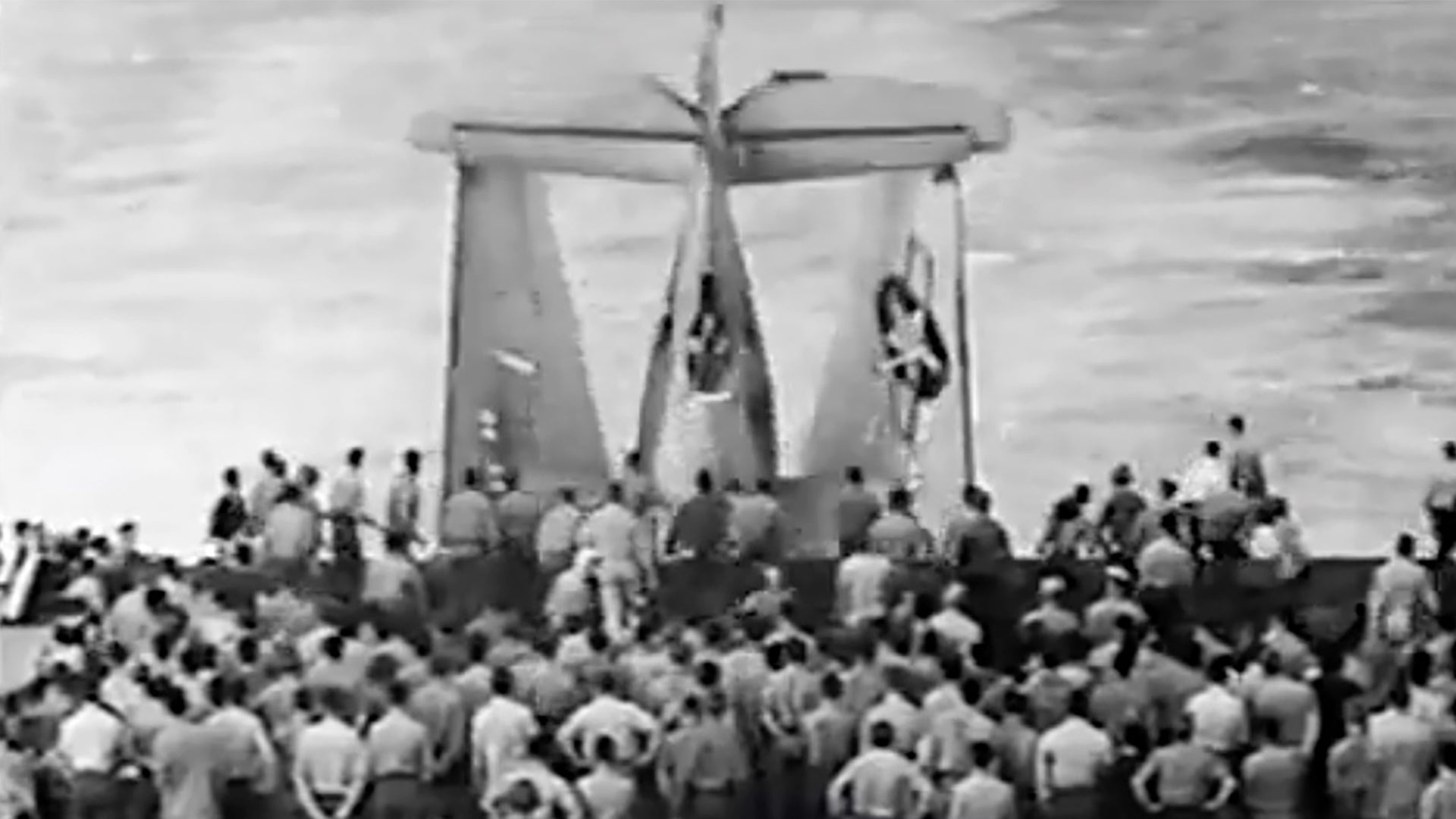Writing about warfare day-in and day-out for years hardens you to the avalanche of conflict-related imagery and video you see on a daily basis, which ranges from gruesome to heroic. This job literally makes you examine the worst and the best humanity has to offer on a daily basis, but once in a while, a piece of media will really move you by surprise. This happened today when @history1history posted a video of a TBM Avenger gunner being buried at sea with his battle damaged aircraft. Apparently, this is the only time this happened during the war.
In the clip, we see the Avenger, which was hit hard by flak, limping back to the carrier. Once it lands, the rear turret gunner’s cockpit is covered up and the aircraft is ceremoniously rolled off the fantail of the ship in a unique burial at sea. You see, Aviation Machinist Mate 2nd Class Loyce Edward Deen’s body was so badly mangled from the anti-aircraft shell that took his life that it couldn’t be removed from the torpedo bomber’s rear cockpit.

Deen was just 23 years old when he died on that fateful mission. The operation he was participating in at the time of his death was the Battle Of Manila. It was two hours into a sortie when his Avenger, which belonged to Torpedo Squadron 15 (VT-15) based aboard the USS Essex (CV-9), was hit by anti-aircraft artillery, killing him instantly.
Before the Battle of Manila, Deen and his Avenger crew flew in many battles, oftentimes returning to the carrier with their aircraft badly damaged. He was wounded on one such mission during the Battle of Leyte Gulf. Instead of going and recovering on a hospital ship or land base, he elected to stay with his Avenger aircrew on the carrier so that he could return to flight as soon as possible.

There is a wonderful website dedicated to Deen and his Avenger crew’s heroics during World War II which you can access here. In it, they describe his final day as such:
“Each day, reveille was sounded on the USS Essex’s intercom at 5:30 am. Breakfast was served in the mess hall at 6:30am. Throughout the night, the planes scheduled for the next day’s mission were being prepared. On the flight deck, the Hellcat fighters were in front so they can take off first and protect the group and the carrier. In the rear were the Avenger and Hell Diver bombers and torpedo planes. After breakfast, pilots attended briefings in the ‘Ready Room’ to get their final orders, weather conditions and the plane that was to be assigned to them. That day, Lt. Cosgrove received tail number #93 – a new plane just acquired in Ulithi Atoll a few days ago. Lt. Cosgrove’s orders were to go after the Japanese cruisers in Manila Bay. After the briefing, Lt. Cosgrove joined his crew, Digby and Loyce, and they went topside to their plane. Loyce climbed into his gun turret for the final time. The VT-15 group took off mid-morning and it would take about two hours to get to the Manila Bay and release the ordinance.
There, they encountered heavy anti-aircraft fire from a Japanese cruiser and Loyce was killed from two AA shells. In the 2001 History Channel documentary film “Battle Group Halsey” interview, Capt. Cosgrove recalled, “Denzek told me over the intercom that Deen was hit bad. Then, Densek came back up thru the small passageway to sit in the cabin behind me. He stayed there until we landed.”
During the attack, the plane and its controls were heavily damaged. Lt. Cosgrove had his hands full and used all his strength and skill to return another un-flyable plane. It was very sad, long and harrowing two-hour flight back to the carrier that included two thunderstorms.
Shortly after Loyce’s burial, the USS Essex went into “general quarters” status for the entire evening due to the Kamikaze attacks around them. On November 6th, 12th, 13th and 14th, Lt. Cosgrove courageously got back into a new plane and attacked those same cruisers in the Bay of Manila. On November 15th, Air Group 15 disengaged from combat missions and returned to Ulithi Atoll to be replaced by Air Group 4 from the USS Bunker Hill.
At Ulithi Atoll, the surviving 45 members of Air Group 15 transferred to the USS Bunker Hill which was returning to Pearl Harbor for a week. Then, the USS Bunker Hill went to Seattle and brought Air Group 15 home.”
It’s amazing to think that Deen launched off the carrier on another mission that day not having any idea that he would not return to the carrier alive, let alone that his mangled corpse would be rolled into the sea along with the aircraft he was flying in.
The sheer number of lives that were sacrificed, many in a cruel flash of happenstance, to win World War II is truly chilling, but metrics alone, and even still images, can’t tell the story of just how brutal the conflict was and how undiscriminating and sudden tragedy was doled out during it, like this short piece of footage.

War is a very nasty business and the glory that goes with it is largely manufactured after the fact. Being blown to pieces and tossed off the stern of a ship inside the broken aircraft that you died in just hours earlier is a somber reminder of that.
Contact the author: Tyler@thedrive.com
